Tectono-Thermal Events of Coal-Bearing Basin in the Northern North China Craton: Evidence from Zircon–Apatite Fission Tracks and Vitrinite Reflectance
Abstract
:1. Introduction
2. Geological Setting
3. Samples and Methods
4. Results
4.1. Random Vitrinite Reflectance and Paleotemperature
4.2. Zircon Fission Tracks (ZFT)
4.3. Apatite Fission Tracks (AFT)
5. Discussion
5.1. Tectonic–Magmatic Activity
5.2. Uplift Cooling Events
6. Conclusions
Author Contributions
Funding
Institutional Review Board Statement
Informed Consent Statement
Data Availability Statement
Acknowledgments
Conflicts of Interest
References
- Tagami, T.; Dumitru, T.A. Provenance and thermal history of the Franciscan accretionary complex: Constraints from zircon fission track thermochronology. J. Geophys. Res. Solid Earth 1996, 101, 11353–11364. [Google Scholar] [CrossRef]
- Spiegel, C.; Kuhlemann, J.; Dunkl, I.; Frisch, W.; Von Eynatten, H.; Balogh, K. The erosion history of the Central Alps: Evidence from zircon fission track data of the foreland basin sediments. Terra Nova 2000, 12, 163–170. [Google Scholar] [CrossRef]
- Bernet, M.; Garver, J.I. Fission-track analysis of detrital zircon. Rev. Mineral. Geochem. 2005, 58, 205–237. [Google Scholar] [CrossRef]
- Cawood, P.A.; Hawkesworth, C.; Dhuime, B. Detrital zircon record and tectonic setting. Geology 2012, 40, 875–878. [Google Scholar] [CrossRef] [Green Version]
- Gao, C.; Liu, J.; Li, D.W.; Wang, F.; Liu, D.M. The constraints of the fission track thermochronology on active time of the Southern Tibetan Detachment System in Cho Oyu, Tibet. Earth Sci. Front. 2014, 21, 372–380. [Google Scholar]
- Chew, D.M.; Spikings, R.A. Geochronology and thermochronology using apatite: Time and temperature, lower crust to surface. Elements 2015, 11, 189–194. [Google Scholar] [CrossRef]
- Li, K.; Jolivet, M.; Zhang, Z.; Li, J.; Tang, W. Long-term exhumation history of the Inner Mongolian Plateau constrained by apatite fission track analysis. Tectonophysics 2016, 666, 121–133. [Google Scholar] [CrossRef]
- Glorie, S.; Agostino, K.; Dutch, R.; Pawley, M.; Hall, J.; Danišík, M.; Evans, N.J.; Collins, A.S. Thermal history and differential exhumation across the Eastern Musgrave Province, South Australia: Insights from low-temperature thermochronology. Tectonophysics 2017, 703, 23–41. [Google Scholar] [CrossRef]
- Gleadow, A.J.; Duddy, I.; Green, P.F.; Lovering, J. Confined fission track lengths in apatite: A diagnostic tool for thermal history analysis. Contrib. Mineral. Petrol. 1986, 94, 405–415. [Google Scholar] [CrossRef]
- Yuan, W.; Dong, J.; Bao, Z. Fission track evidences for tectonic activity in Altay Mountains, Xinjiang, northwestern China. Earth Sci. Front. 2004, 11, 461–468. [Google Scholar]
- Li, J.F.; Tang, W.H.; Liu, Z.; Zhang, Z.C. Apatite fission track analysis of Upper Jurassic Houcheng Formation at Qianjiadian area, Beijing and its geological significance. Chin. J. Geophys. 2010, 53, 2907–2917. [Google Scholar]
- Zou, B.; Wang, G.Z.; Deng, J.H. Evidence for apatite fission track of Pliocene rapid uplift of Zhongdian region on southeastern margin of Tibetan Plateau, China. J. Chengdu Univ. Technol. 2014, 41, 227–236. [Google Scholar]
- Glorie, S.; Alexandrov, I.; Nixon, A.; Jepson, G.; Gillespie, J.; Jahn, B.M. Thermal and exhumation history of Sakhalin Island (Russia) constrained by apatite U-Pb and fission track thermochronology. J. Asian Earth Sci. 2017, 143, 326–342. [Google Scholar] [CrossRef]
- Wang, S.C.; Jing, G.R.; Kang, T.S. Thermal history inversion based on apatite fission track data. Chin. Sci. Bull. 1994, 39, 816–819. [Google Scholar]
- Schito, A.; Andreucci, B.; Aldega, L.; Corrado, S.; Di Paolo, L.; Zattin, M.; Szaniawski, R.; Jankowski, L.; Mazzoli, S. Burial and exhumation of the western border of the Ukrainian Shield (Podolia): A multi-disciplinary approach. Basin Res. 2018, 30, 532–549. [Google Scholar] [CrossRef] [Green Version]
- Caricchi, C.; Aldega, L.; Barchi, M.; Corrado, S.; Grigo, D.; Mirabella, F.; Zattin, M. Exhumation patterns along shallow low-angle normal faults: An example from the Altotiberina active fault system (Northern Apennines, Italy). Terra Nova 2015, 27, 312–321. [Google Scholar] [CrossRef]
- Rantitsch, G.; Bhattacharyya, A.; Günbati, A.; Schulten, M.-A.; Schenk, J.; Letofsky-Papst, I.; Albering, J. Microstructural evolution of metallurgical coke: Evidence from Raman spectroscopy. Int. J. Coal Geol. 2020, 227, 103546. [Google Scholar] [CrossRef]
- Karayigit, A.I.; Atalay, M.; Oskay, R.G.; Córdoba, P.; Querol, X.; Bulut, Y. Variations in elemental and mineralogical compositions of Late Oligocene, Early and Middle Miocene coal seams in the Kale-Tavas Molasse sub-basin, SW Turkey. Int. J. Coal Geol. 2020, 218, 103366. [Google Scholar] [CrossRef]
- Bicca, M.M.; Kalkreuth, W.; da Silva, T.F.; de Oliveira, C.H.E.; Genezini, F.A. Thermal and depositional history of Early-Permian Rio Bonito Formation of southern Paraná Basin–Brazil. Int. J. Coal Geol. 2020, 228, 103554. [Google Scholar] [CrossRef]
- Yu, K.; Ju, Y.W.; Qian, J.; Qu, Z.H.; Shao, C.J.; Yu, K.L.; Shi, Y. Burial and thermal evolution of coal-bearing strata and its mechanisms in the southern North China Basin since the late Paleozoic. Int. J. Coal Geol. 2018, 198, 100–115. [Google Scholar] [CrossRef]
- Karayigit, A.I.; Mastalerz, M.; Oskay, R.G.; Gayer, R.A. Coal petrography, mineralogy, elemental compositions and palaeoenvironmental interpretation of Late Carboniferous coal seams in three wells from the Kozlu coalfield (Zonguldak Basin, NW Turkey). Int. J. Coal Geol. 2018, 187, 54–70. [Google Scholar] [CrossRef]
- Izart, A.; Barbarand, J.; Michels, R.; Privalov, V.A. Modelling of the thermal history of the Carboniferous Lorraine Coal Basin: Consequences for coal bed methane. Int. J. Coal Geol. 2016, 168, 253–274. [Google Scholar] [CrossRef]
- Littke, R.; Urai, J.L.; Uffmann, A.K.; Risvanis, F. Reflectance of dispersed vitrinite in Palaeozoic rocks with and without cleavage: Implications for burial and thermal history modeling in the Devonian of Rursee area, northern Rhenish Massif, Germany. Int. J. Coal Geol. 2012, 89, 41–50. [Google Scholar] [CrossRef]
- Sachsenhofer, R. Geodynamic Controls on Deposition and Maturation of Coal in the Eastern Alps. Mitt. Österr. Geol. Ges. 1999, 92, 185–194. [Google Scholar]
- Burkhard, M.; Kalkreuth, W. Coalification in the northern Wildhorn nappe and adjacent units, western Switzerland. Implications for tectonic burial histories. Int. J. Coal Geol. 1989, 11, 47–64. [Google Scholar] [CrossRef] [Green Version]
- Corrado, S.; Schito, A.; Romano, C.; Grigo, D.; Poe, B.; Aldega, L.; Caricchi, C.; Di Paolo, L.; Zattin, M. An integrated platform for thermal maturity assessment of polyphase, long-lasting sedimentary basins, from classical to brand-new thermal parameters and models: An example from the on-shore Baltic Basin (Poland). Mar. Pet. Geol. 2020, 122, 104547. [Google Scholar] [CrossRef]
- Zhai, M.G. Tectonic evolution and metallogenesis of North China Craton. Miner. Depos. 2010, 29, 24–36. [Google Scholar]
- Pan, G.T.; Xiao, Q.H.; Lu, S.N.; Deng, J.F.; Feng, Y.M.; Zhang, K.X.; Zhang, Z.Y.; Wang, F.G.; Xing, G.F.; Hao, G.J.; et al. Subdivision of tectonic units in China. Geol. China 2009, 36, 1–16+255+17–28. [Google Scholar]
- Li, Z.H.; Dong, S.W.; Qu, H.J. Timing of the initiation of the Jurassic Yanshan movement on the North China Craton: Evidence from sedimentary cycles, heavy minerals, geochemistry, and zircon U–Pb geochronology. Int. Geol. Rev. 2014, 56, 288–312. [Google Scholar] [CrossRef]
- Li, Z.H.; Qu, H.J.; Gong, W.B. Late Mesozoic basin development and tectonic setting of the northern North China Craton. J. Asian Earth Sci. 2015, 114, 115–139. [Google Scholar] [CrossRef]
- Li, Z.H.; Qu, H.J.; Yang, Y.H.; Gong, W.B. Late Mesozoic sedimentary-volcanic filling record in Yungang basin and its tectonic implications. Geol. China 2016, 43, 1481–1494. [Google Scholar]
- Zhou, R.; Liu, D.N.; Zhou, A.C.; Zou, Y. Provenance analyses of early Mesozoic sediments in the Ningwu basin: Implications for the tectonic–palaeogeographic evolution of the northcentral North China Craton. Int. Geol. Rev. 2019, 61, 86–108. [Google Scholar] [CrossRef]
- Zhou, R.; Liu, D.N.; Zhou, A.C.; Zou, Y.; Xie, J. A synthesis of late Paleozoic and early Mesozoic sedimentary provenances and constraints on the tectonic evolution of the northern North China Craton. J. Asian Earth Sci. 2019, 185, 104029. [Google Scholar] [CrossRef]
- Li, H.Y. Destruction of North China Craton: Insights from temporal and spatial evolution of the proto-basins and magmatism. Sci. China Earth Sci. 2013, 56, 464–478. [Google Scholar] [CrossRef] [Green Version]
- Liu, S.F.; Su, S.; Zhang, G.W. Early Mesozoic basin development in North China: Indications of cratonic deformation. J. Asian Earth Sci. 2013, 62, 221–236. [Google Scholar] [CrossRef]
- Li, Z.H.; Xi, S.L.; Feng, S.B.; Liu, X.S. 150 Million year history of North China Craton disruption preserved in Mesozoic sediments of the Ordos Basin. Int. Geol. Rev. 2016, 58, 1417–1442. [Google Scholar] [CrossRef]
- Yang, M.H.; Liu, C.Y.; Zeng, P.; Bai, H.; Zhou, J. Prototypes of Late Triassic sedimentary basins of North China Craton (NCC) and deformation pattern of its early destruction. Geol. Rev. 2012, 58, 1–18. [Google Scholar]
- Liu, D.N. The Coupling Relationship of Coal Metamorphism and Sedimentary-Tectonic Magmatic Activity for Datong Double Period Coal-Bearing Basin. Ph.D. Thesis, Taiyuan University of Technology, Taiyuan, China, 2015. [Google Scholar]
- Lu, X.P.; Wu, F.Y.; Zhao, C.B.; Zhang, Y.B. Zircon U-Pb ages of Indochinese granites in the Tonghua area and their relationship with collisional orogeny in the Dabie-Sulu superhigh pressure belt. Chin. Sci. Bull. 2003, 48, 843–849. [Google Scholar] [CrossRef]
- Yang, J.H.; Chung, S.L.; Wilde, S.A.; Wu, F.Y.; Chu, M.F.; Lo, C.H.; Fan, H.R. Petrogenesis of post-orogenic syenites in the Sulu Orogenic Belt, East China: Geochronological, geochemical and Nd–Sr isotopic evidence. Chem. Geol. 2005, 214, 99–125. [Google Scholar] [CrossRef]
- Xu, W.L.; Yang, C.H.; Yang, D.B.; Pei, F.P.; Wang, Q.H.; Ji, W.Q. Mesozoic high-Mg diorites in eastern North China craton: Constraii on the mechanism of lithospheric thinning. Earth Sci. Front. 2006, 13, 120–129. [Google Scholar]
- Yang, J.H.; Wu, F.Y.; Wilde, S.A.; Liu, X.M. Petrogenesis of Late Triassic granitoids and their enclaves with implications for post-collisional lithospheric thinning of the Liaodong Peninsula, North China Craton. Chem. Geol. 2007, 242, 155–175. [Google Scholar] [CrossRef]
- Zhu, R.X.; Yang, J.H.; Wu, F.Y. Timing of destruction of the North China Craton. Lithos 2012, 149, 51–60. [Google Scholar] [CrossRef]
- Chang, J.L.; Ren, D.J.; Gao, Q. The Datong formation of Ningwu coalfield, Shanxi. J. Stratigr. 1996, 20, 262–270. [Google Scholar]
- Zhao, M.P. Studies on the relationship between Kouquan fault and Datong Jurassic Coal Field. North China Geol. Miner. Mag. 1996, 11, 93–98. [Google Scholar]
- Zhao, J.F.; Liu, C.Y.; Wang, X.M.; Ma, Y.P.; Huang, L. Uplifting and evolution characteristics in the Lüliang Mountain and its adjacent area during the Meso-Cenozoic. Geol. Rev. 2009, 55, 663–672. [Google Scholar]
- Zhao, J.F.; Liu, C.Y.; Wang, X.M.; Zhang, C. Migration of depocenters and accumulation centers and its indication of subsidence centers in the Mesozoic Ordos Basin. Acta Geol. Sin. 2009, 83, 278–294. [Google Scholar] [CrossRef]
- Shao, J.A.; Zhang, Y.B.; Zhang, L.Q.; Mu, B.L.; Wang, P.Y.; Guo, F. Early Mesozoic dike swarms of carbonatites and lamprophyres in Datong area. Acta Petrol. Sin. 2003, 19, 93–104. [Google Scholar]
- Liu, S.; Feng, C.X.; Hu, R.Z.; Lai, S.C.; Coulson, I.M.; Fung, G.Y.; Yang, Y.H. Geochemical, Sr-Nd isotope,and zircon U-Pb geochronological constraints on the origin of Early Cretaceous carbonatite dykes, northern Shanxi Province, China. Acta Petrol. Sin. 2014, 30, 350–360. [Google Scholar]
- International Committee for Coal and Organic Petrology (ICCP). The new vitrinite classification (ICCP System 1994). Fuel 1998, 77, 349–358. [Google Scholar] [CrossRef]
- International Organization for Standardization. Methods for the Petrographic Analysis of Coals. In Method of Determining Microscopically the Reflectance of Vitrinite; International Organization for Standardization: Geneva, Switzerland, 2009; ISBN 978-0-580-56505-2. [Google Scholar]
- International Committee for Coal and Organic Petrology (ICCP). The new inertinite classification (ICCP System 1994). Fuel 2001, 80, 459–471. [Google Scholar] [CrossRef]
- O’Keefe, J.M.K.; Bechtel, A.; Christanis, K.; Dai, S.; DiMichele, W.A.; Eble, C.F.; Esterle, J.S.; Mastalerz, M.; Raymond, A.L.; Valentim, B.V.; et al. On the fundamental difference between coal rank and coal type. Int. J. Coal Geol. 2013, 118, 58–87. [Google Scholar] [CrossRef]
- Barker, C.E.; Pawlewicz, M.J. An empirical determination of the minimum number of measurements needed to estimate the mean random vitrinite reflectance of disseminated organic matter. Org. Geochem. 1993, 20, 643–651. [Google Scholar] [CrossRef]
- Taylor, G.H.; Teichmüller, M.; Davis, A.; Diessel, C.; Littke, R.; Robert, P. Organic Petrology; Gebrüder Borntraeger: Berlin/Stuttgart, Germany, 1998; pp. 453–457. [Google Scholar]
- Balestra, M.; Corrado, S.; Aldega, L.; Gasparo Morticelli, M.; Sulli, A.; Rudkiewicz, J.-L.; Sassi, W. Thermal and structural modeling of the Scillato wedge-top basin source-to-sink system: Insights into the Sicilian fold-and-thrust belt evolution (Italy). GSA Bull. 2019, 131, 1763–1782. [Google Scholar] [CrossRef]
- Corrado, S.; Aldega, L.; Perri, F.; Critelli, S.; Muto, F.; Schito, A.; Tripodi, V. Detecting syn-orogenic extension and sediment provenance of the Cilento wedge top basin (southern Apennines, Italy): Mineralogy and geochemistry of fine-grained sediments and petrography of dispersed organic matter. Tectonophysics 2018, 750, 404–418. [Google Scholar] [CrossRef]
- Liu, B.; Teng, J.; Mastalerz, M.; Schieber, J. Assessing the thermal maturity of black shales using vitrinite reflectance: Insights from Devonian black shales in the eastern United States. Int. J. Coal Geol. 2020, 220, 103426. [Google Scholar] [CrossRef]
- Ferreiro Mählmann, R.; Le Bayon, R. Vitrinite and vitrinite like solid bitumen reflectance in thermal maturity studies: Correlations from diagenesis to incipient metamorphism in different geodynamic settings. Int. J. Coal Geol. 2016, 157, 52–73. [Google Scholar] [CrossRef]
- Fulton, P.M.; Harris, R.N. Thermal considerations in inferring frictional heating from vitrinite reflectance and implications for shallow coseismic slip within the Nankai Subduction Zone. Earth Planet. Sci. Lett. 2012, 335, 206–215. [Google Scholar] [CrossRef]
- Chen, Z.Z.; Liu, G.D.; Hao, S.S. A Corrected Method of Using Vitrinite Reflectance Data to Estimate the Thickness of Sediment Removed at an Unconformity. Acta Sedimentol. Sin. 1999, 17, 141–144. [Google Scholar]
- Teichmüller, M. The genesis of coal from the viewpoint of coal petrology. Int. J. Coal Geol. 1989, 12, 1–87. [Google Scholar] [CrossRef]
- Hood, A.; Gutjahr, C.C.M.; Heacock, R.L. Organic Metamorphism and the Generation of Petroleum1. AAPG Bull. 1975, 59, 986–996. [Google Scholar]
- Karweil, J. Die metamorphose der kohlen vom standpunkt der physikalischen chemie. Z. Dtsch. Geol. Ges. 1956, 107, 132–139. [Google Scholar]
- Barker, C.E.; Pawlewicz, M.J. Calculation of Vitrinite Reflectance from Thermal Histories and Peak Temperatures. In Vitrinite Reflectance as a Maturity Parameter; ACS Symposium Series; American Chemical Society: Washington, DC, USA, 1994; pp. 216–229. [Google Scholar]
- Barker, C.E.; Bone, Y.; Lewan, M.D. Fluid inclusion and vitrinite-reflectance geothermometry compared to heat-flow models of maximum paleotemperature next to dikes, western onshore Gippsland Basin, Australia. Int. J. Coal Geol. 1998, 37, 73–111. [Google Scholar] [CrossRef]
- Barker, C.E.; Pawlewicz, M. The correlation of vitrinite reflectance with maximum temperature in humic organic matter. In Paleogeothermics; Springer: Berlin/Heidelberg, Germany, 1986; pp. 79–93. [Google Scholar]
- Teichmüller, M. Anwendung kohlenpetrographischer Methoden bei der Erdöl-und Erdgasprospektion. Erdöl Kohle 1971, 24, 69–76. [Google Scholar]
- Connan, J. Time-temperature relation in oil genesis: Geologic notes. AAPG Bull. 1974, 58, 2516–2521. [Google Scholar]
- Burnham, A.K.; Sweeney, J.J. A chemical kinetic model of vitrinite maturation and reflectance. Geochim. Cosmochim. Acta 1989, 53, 2649–2657. [Google Scholar] [CrossRef]
- Xiao, X.M.; Liu, Z.F.; Shen, J.G.; Liu, D.H. A new method for determining palaeo-geothermal gradients in hydrocarbon-bearing basins -vitrinite reflectance gradient method. Chin. Sci. Bull. 1998, 43, 2340–2343. [Google Scholar]
- Jiang, G.H.; Hu, R.Z.; Fang, W.X. Progress in deduction of paleotemperature from vitrinite reflectance data. Geol.-Geochem. 2001, 29, 40–45. [Google Scholar]
- Wang, W.; Zhou, Z.; Yu, P. Relations between vitrinite reflectance, peak temperature and its neighboring thmperature variation rate: A comparison of methods. Chin. J. Geophys. 2005, 48, 1375–1386. [Google Scholar] [CrossRef]
- Ran, Q.G.; Hu, G.Y.; Chen, F.J. The inversion of thermal processes from vitrinite reflectance. Pet. Explor. Dev. 1998, 25, 29–32. [Google Scholar]
- Yao, H.; Ren, Y.; Shen, B. Reconstruction of the paleogeothermal gradient in the Zhongyuan area, Bohai Bay Basin, East China. Earth Sci. Front. 2006, 13, 135. [Google Scholar]
- Li, X. Study on Late Cretaceous-Cenozoic exhumation of the Yanji area, NE China: Insights from low-temperature thermochronology. Acta Geochim. 2019, 38, 815–833. [Google Scholar] [CrossRef]
- Jin, W.; Liu, Y.Q.; Wang, C.S. The application of the apatite fission track dating to the geothermal history in the northern piedmont zone of the Turpan depression, (Xinjiang). Sediment. Geol. Tethyan Geol. 2004, 24, 56–61. [Google Scholar]
- He, J.Q.; Ding, R.X.; Liang, S.Y.; Zhang, L.; Shan, X.J.; Jin, W.; Liu, Y.Q.; Wang, C.S. Study of thermal evolution of the North Yellow Sea basin based on apatite fission track data. Chin. J. Geophys. 2014, 57, 3347–3353. [Google Scholar]
- Dunkl, I. Trackkey: A Windows program for calculation and graphical presentation of fission track data. Comput. Geosci. 2002, 28, 3–12. [Google Scholar] [CrossRef] [Green Version]
- Tian, C.S.; Yuan, W.M.; Zeng, X.P.; Zhang, A.K.; Zhu, C.B.; Sun, F.F.; Ma, Z.Y.; Zhang, L.T.; Hao, N.N. Zircon fission track dating for mineralizing ages in IV ore-belt of Hariza polymetallic mining district, Eastern Kunlun Mountains, Qinghai-Tibet Plateau. Nucl. Tech. 2015, 38, 68–73. [Google Scholar]
- Yang, L.; Yuan, W.M.; Zhu, C.B.; Hong, S.J.; Li, S.Y.; Feng, Z.R.; Zhang, A.K. Mesozoic uplift exhumation history of East Kunlun. Acta Petrol. Sin. 2021, 37, 3781–3796. [Google Scholar]
- Bai, X.F.; Li, W.H. Coal characteristics and governed factors for coal properties of Datong Jassic 10-11# coal. Coal Convers. 2001, 24, 21–23+70. [Google Scholar]
- Qu, S.D.; Liu, C.Y.; Li, J.; Chen, S.Q. Fission track thermochronology evidence for Cenozoic uplifting of the southern Daheishan in Jilin, China. J. Cent. South Univ. 2014, 45, 3893–3899. [Google Scholar]
- Brandon, M. Decomposition of mixed grain age distributions using Binomfit. On Track 2002, 24, 13–18. [Google Scholar]
- Han, W.; Lu, J.C.; Zhang, Y.P.; Li, Y.H.; Wei, J.C.; Liu, X. Apatite fission track and its petroleum geological significance of the Ejina area and its vicinity, Western Inner Mongolia. Geotecton. Metallog. 2014, 38, 647–655. [Google Scholar]
- Yin, J.H.; Zhou, A.C. Petrological characteristics and tectonic significance of the Jiugaoshan volcanic rock in Datong, Shanxi Province. J. Taiyuan Univ. Technol. 2013, 44, 627–631+636. [Google Scholar]
- Chen, W.J.; Liu, R.X.; Sun, J.Z.; Li, D.M. Preliminary K-Ar age determination of the quaternary basalts in Datong volcanic area. Quat. Sci. 1986, 7, 96–102. [Google Scholar]
- Song, X.X.; Ma, H.T.; Li, K.J.; Liu, D.N.; Zhao, J.G.; Xue, D.S. Study on coal petrology characteristics of contact metamorphosed coal from Carboniferous-Permian in Datong Coalfield. Coal Sci. Technol. 2020, 48, 182–191. [Google Scholar]
- Zhang, Y.Q.; Liao, C.Z.; Shi, W. On the Jurassic deformation in and around the Ordos Basin, North China. Earth Sci. Front. 2007, 14, 182. [Google Scholar] [CrossRef]
- Li, Z.H.; Feng, S.B.; Yuan, X.Q.; Qu, H.J. Chronology and its significance of the Lower Jurassic tuff in Ordos Basin and its periphery. Oil Gas Geol. 2014, 35, 729–741. [Google Scholar]
- Yang, X.; Yang, Y.; Ji, L.; Su, C.; Zheng, M.; Zhao, L. Stages and characteristics of thermal actions in eastern part of Ordos Basin. Acta Geol. Sin. 2006, 80, 705–711. [Google Scholar]
- Xiao, Y.Y.; Ren, Z.L.; Qin, J.F.; Zeng, Z. Geochemistry and zircon LA-ICP MS U-Pb dating of the Zijinshan alkaline complex in the Linxian County, Shanxi Province: Geological implication. Geol. Rev. 2007, 53, 656–663. [Google Scholar]
- Ying, J.; Zhang, H.; Sun, M.; Tang, Y.; Zhou, X.; Liu, X. Petrology and geochemistry of Zijinshan alkaline intrusive complex in Shanxi Province, western North China Craton: Implication for magma mixing of different sources in an extensional regime. Lithos 2007, 98, 45–66. [Google Scholar] [CrossRef]
- Chang, Z.G.; Yang, H.; Zhou, A.C. LA-ICP-MS zircon U-Pb geochronology of the Huyanshan alkaline intrusive complex in the Lüliang Mountain of North China Craton and its geological significance. Geol. Bull. China 2017, 36, 372–380. [Google Scholar]
- Ren, Z.L.; Zhao, Z.Y.; Chen, G.; Wang, S.C. Tectonic thermal events of Late Mesozoic in Qinshui basin. Oil Gas Geol. 1999, 20, 48–50. [Google Scholar]
- Ren, Z.L.; Zhang, S.; Gao, S.L.; Cui, J.P.; Liu, X.S. Research on region of maturation anomaly and formation time in Ordos Basin. Acta Geol. Sin. 2006, 80, 674–684. [Google Scholar]
- Ren, Z.L.; De, M.X.; Chi, Y.L.; Ren, Y.G.; Liang, Y. Restoration of thermal history of the Permo-Carboniferous basement in the Songliao Basin. Oil Gas Geol. 2011, 32, 430–439. [Google Scholar]
- Guo, W.Z.; Cheng, Y.H.; Gao, Y.P.; Chen, Z.G.; Zhang, Z.W.; Wang, C. Structural characteristics and coal-bearing boundaries of Taiyuan Formation in Datong coalfield. Coal Geol. Explor 2015, 43, 1–7. [Google Scholar]
- Ren, Z.L. Thermal history of Ordos Basin assessed by apatite fission track analysis. Chin. J. Geophys. 1995, 38, 339–349. [Google Scholar]
- Liu, C.Y.; Zhao, H.G.; Gui, X.J.; Yue, L.P.; Zhao, J.F.; Wang, J.Q. Space-time coordinate of the evolution and reformation and mineralization response in Ordos basin. Acta Geol. Sin. 2006, 80, 617–638. [Google Scholar]
- Liu, C.Y.; Zhao, H.G.; Zhang, S.; Wang, J.Q. The important turning period of evolution in the Tibet-Himalayan tectonic domain. Earth Sci. Front. 2009, 16, 1–12. [Google Scholar]
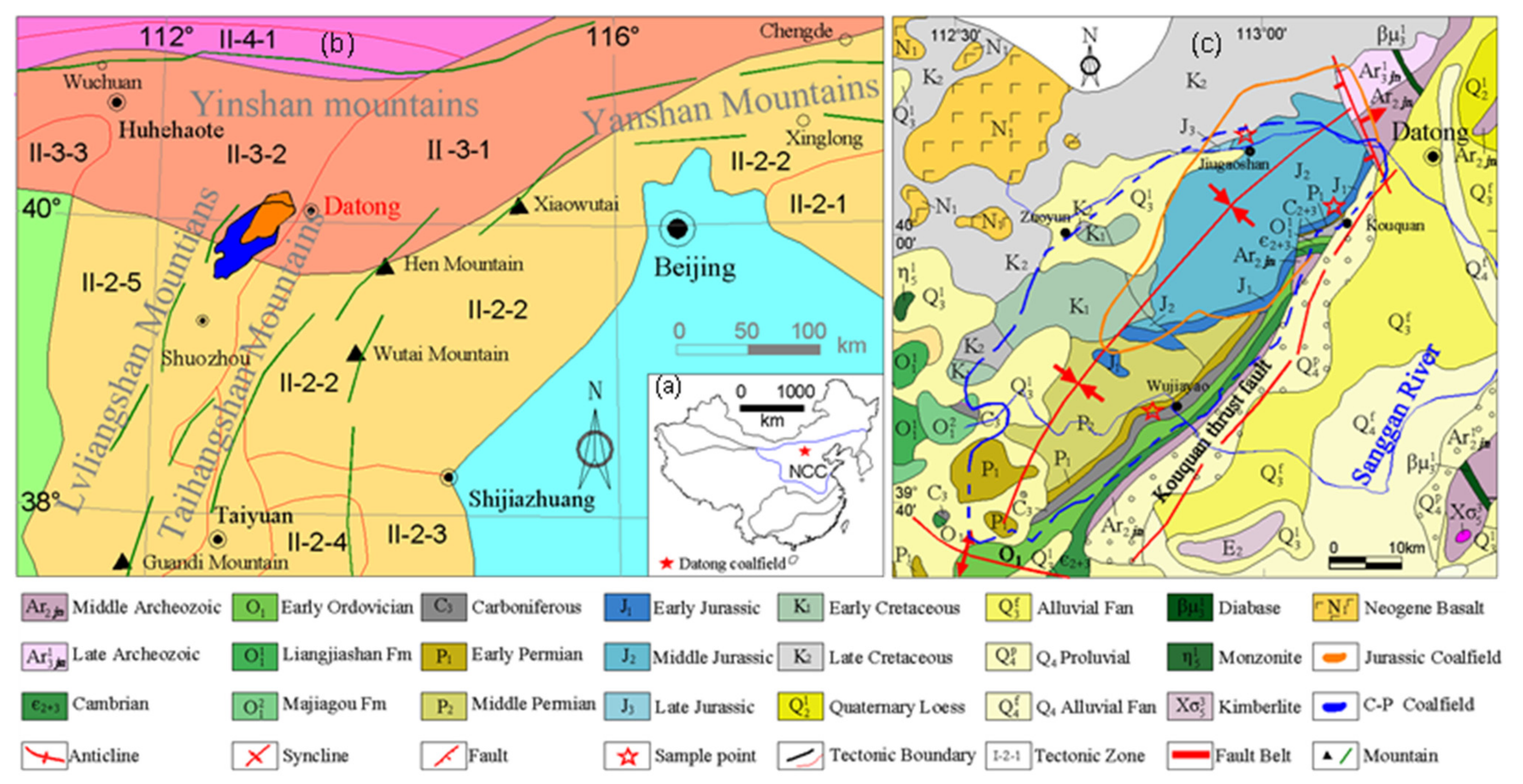

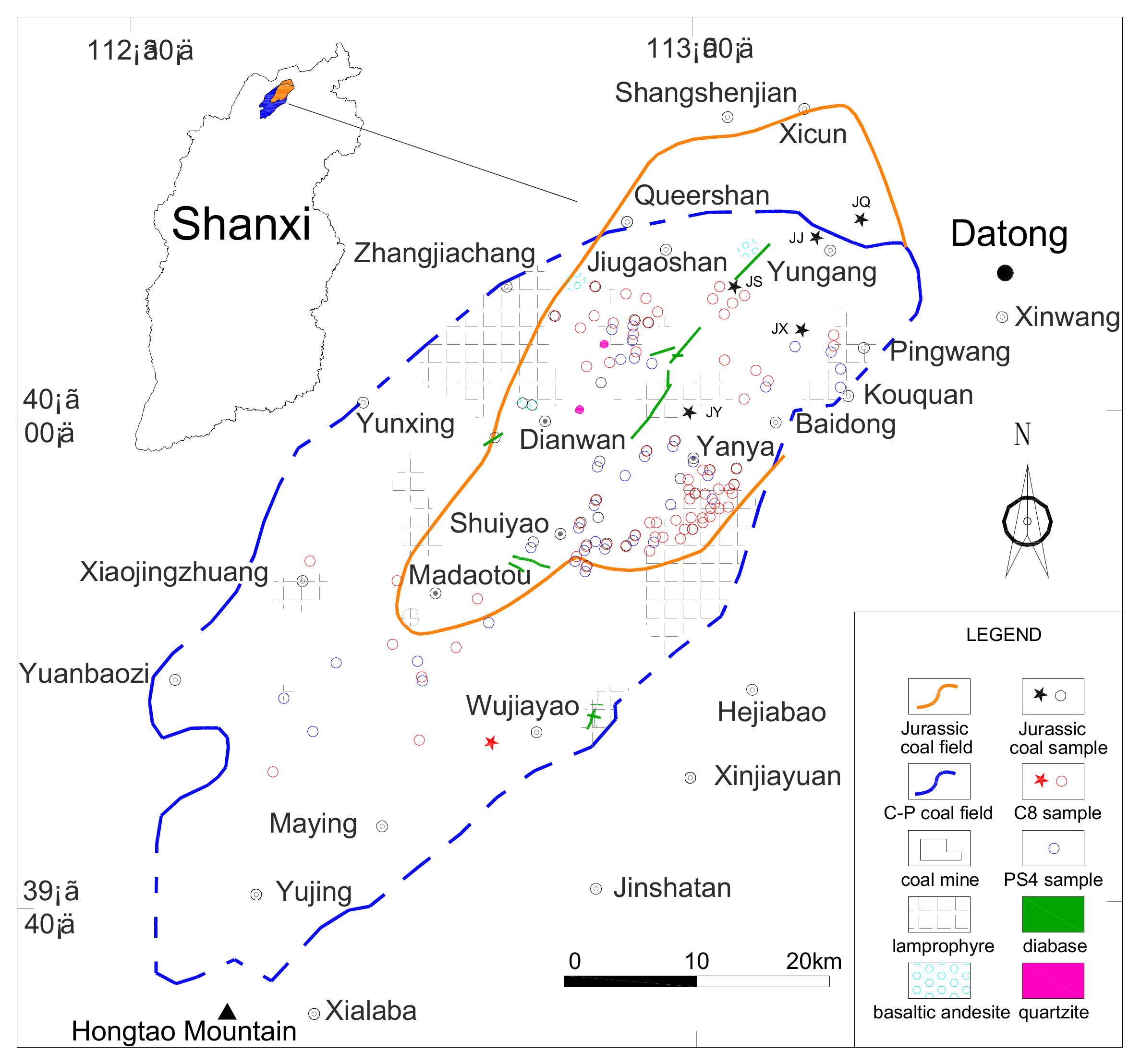
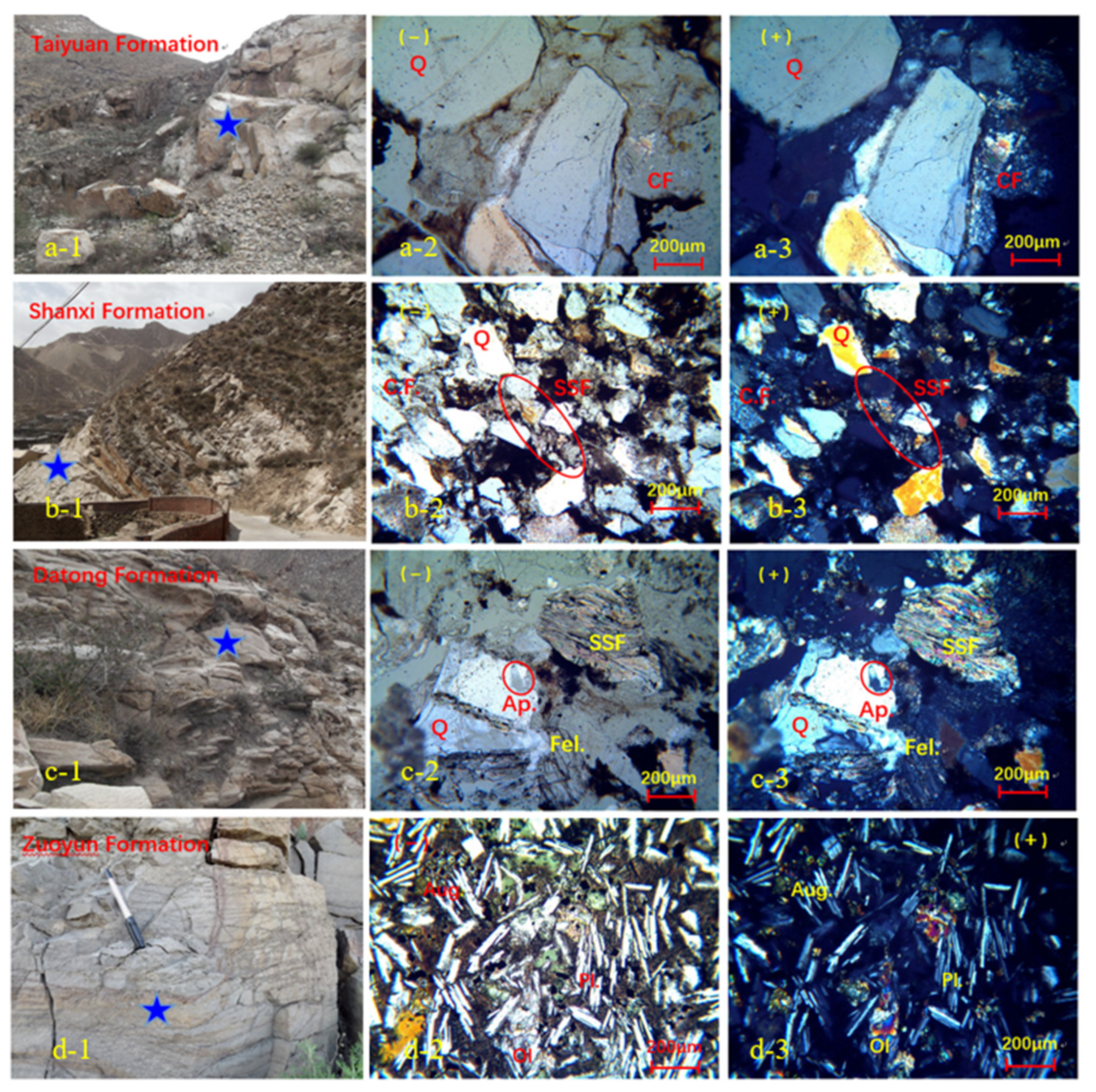
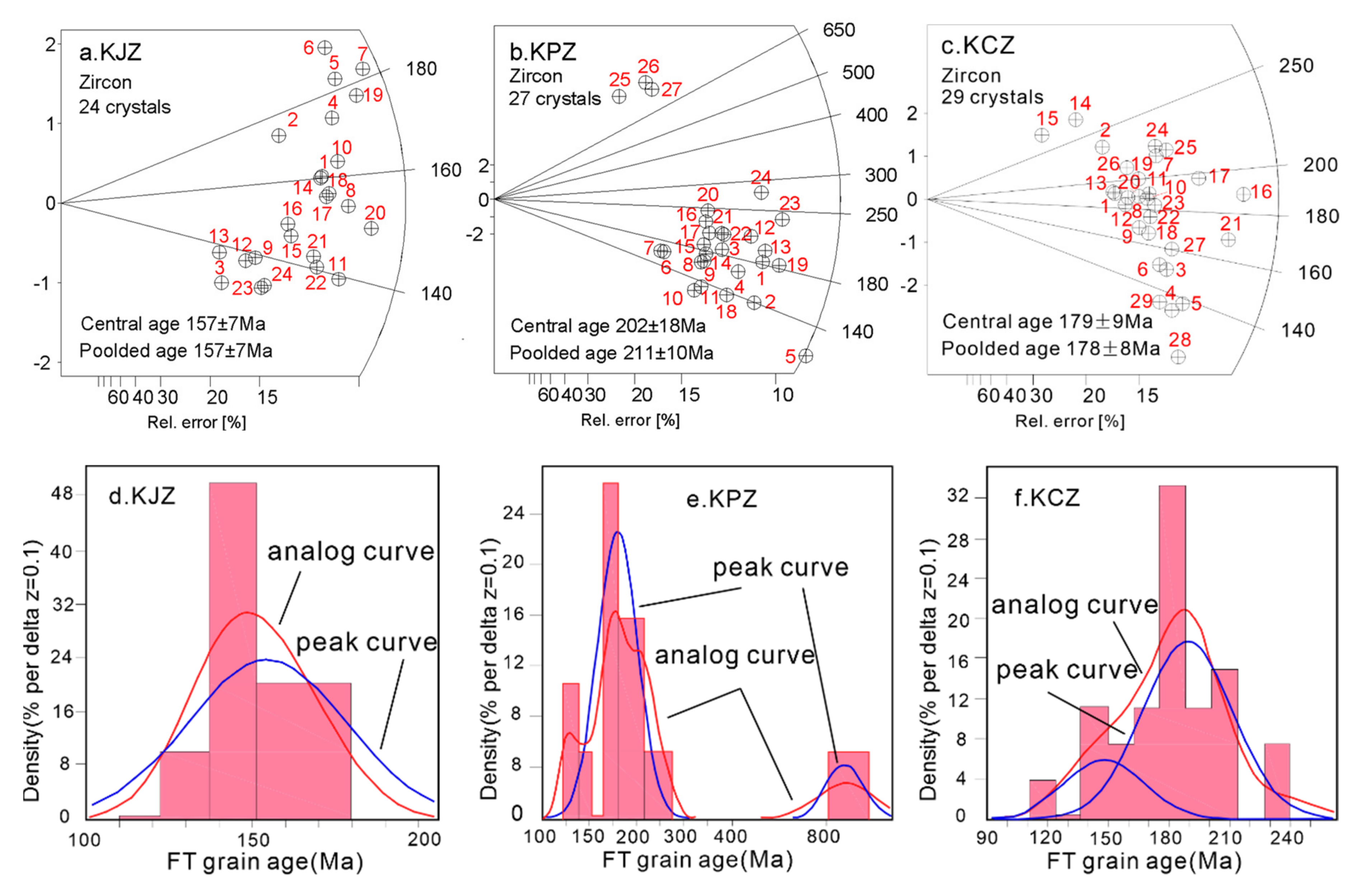
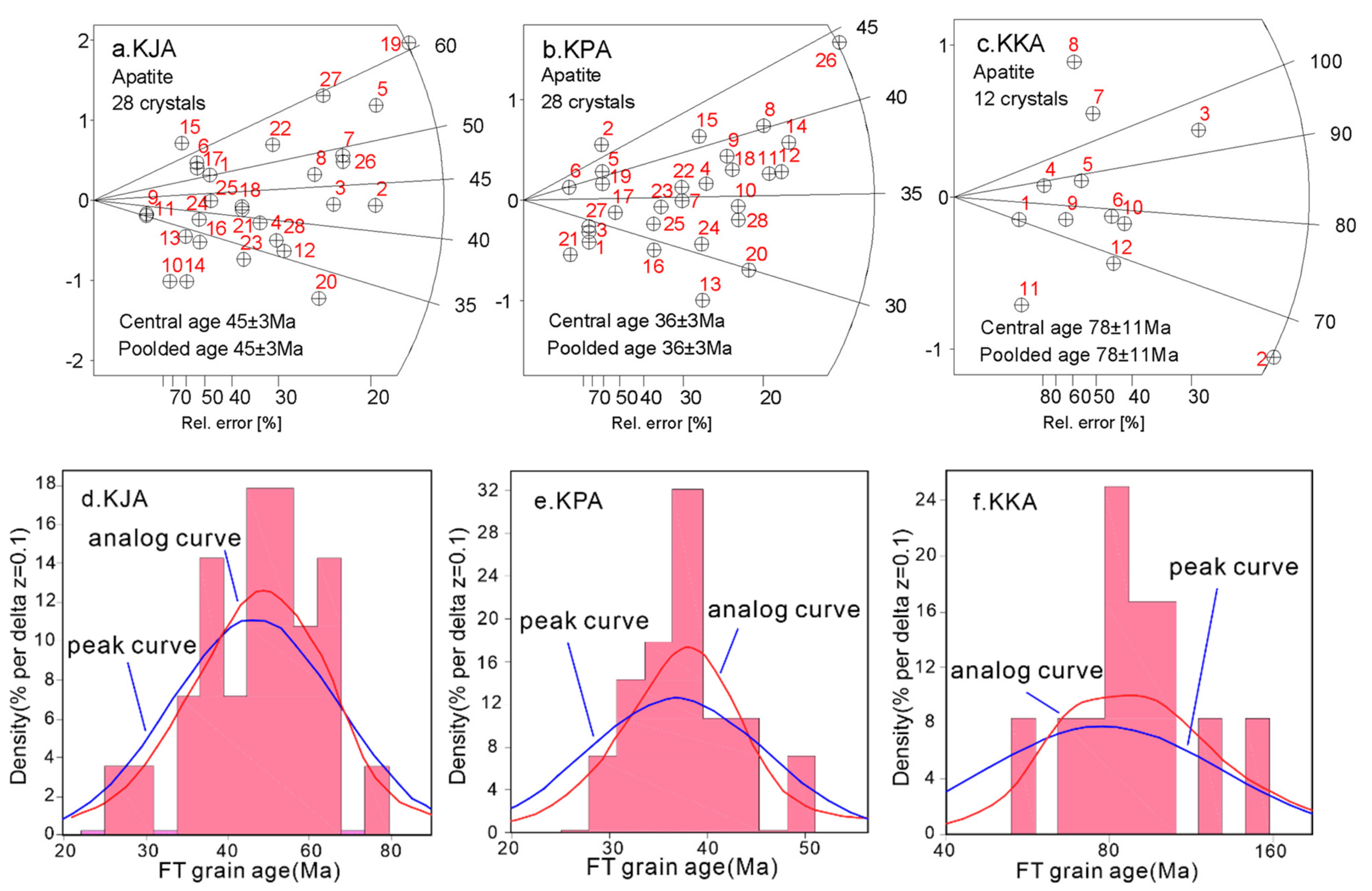
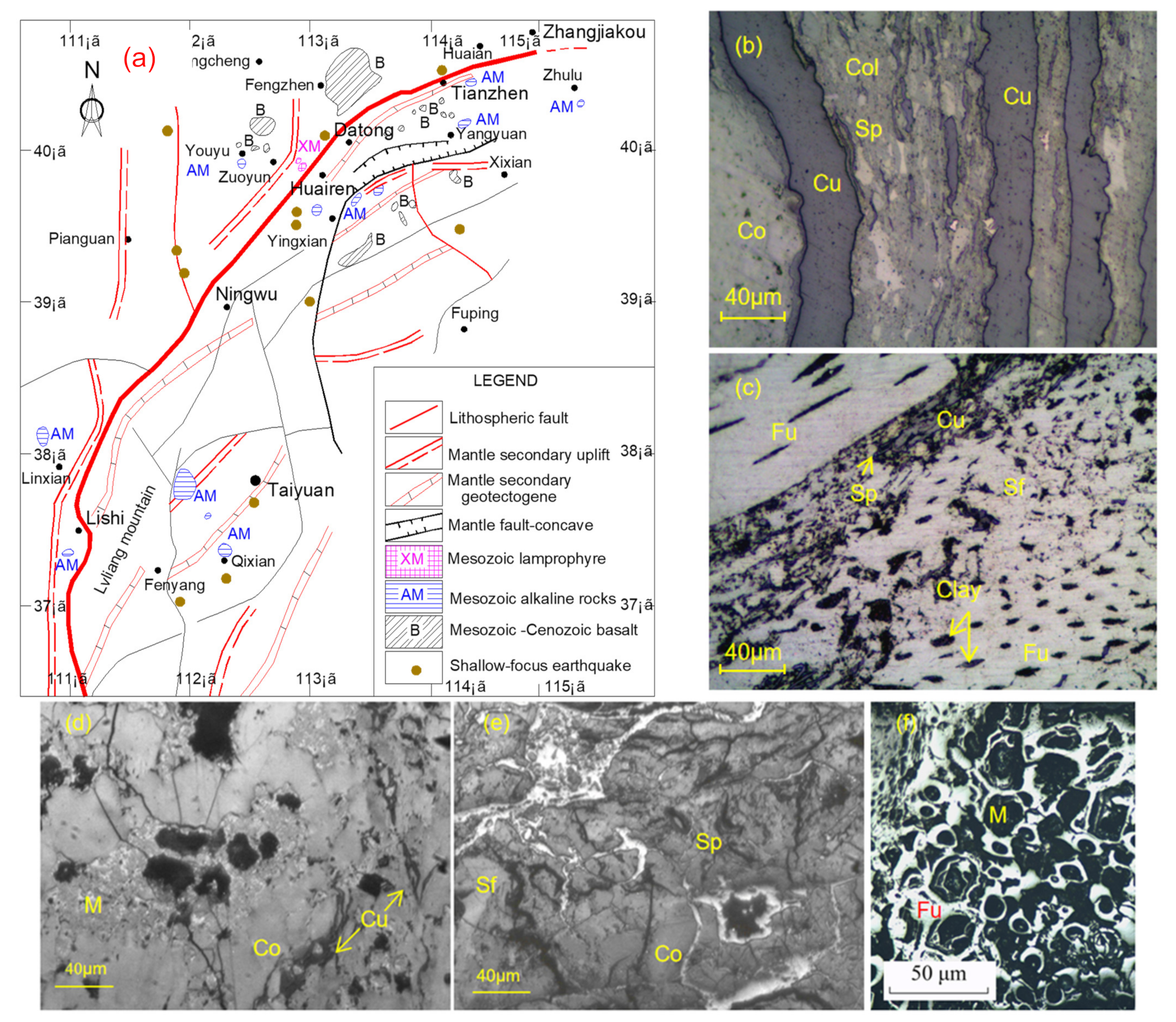
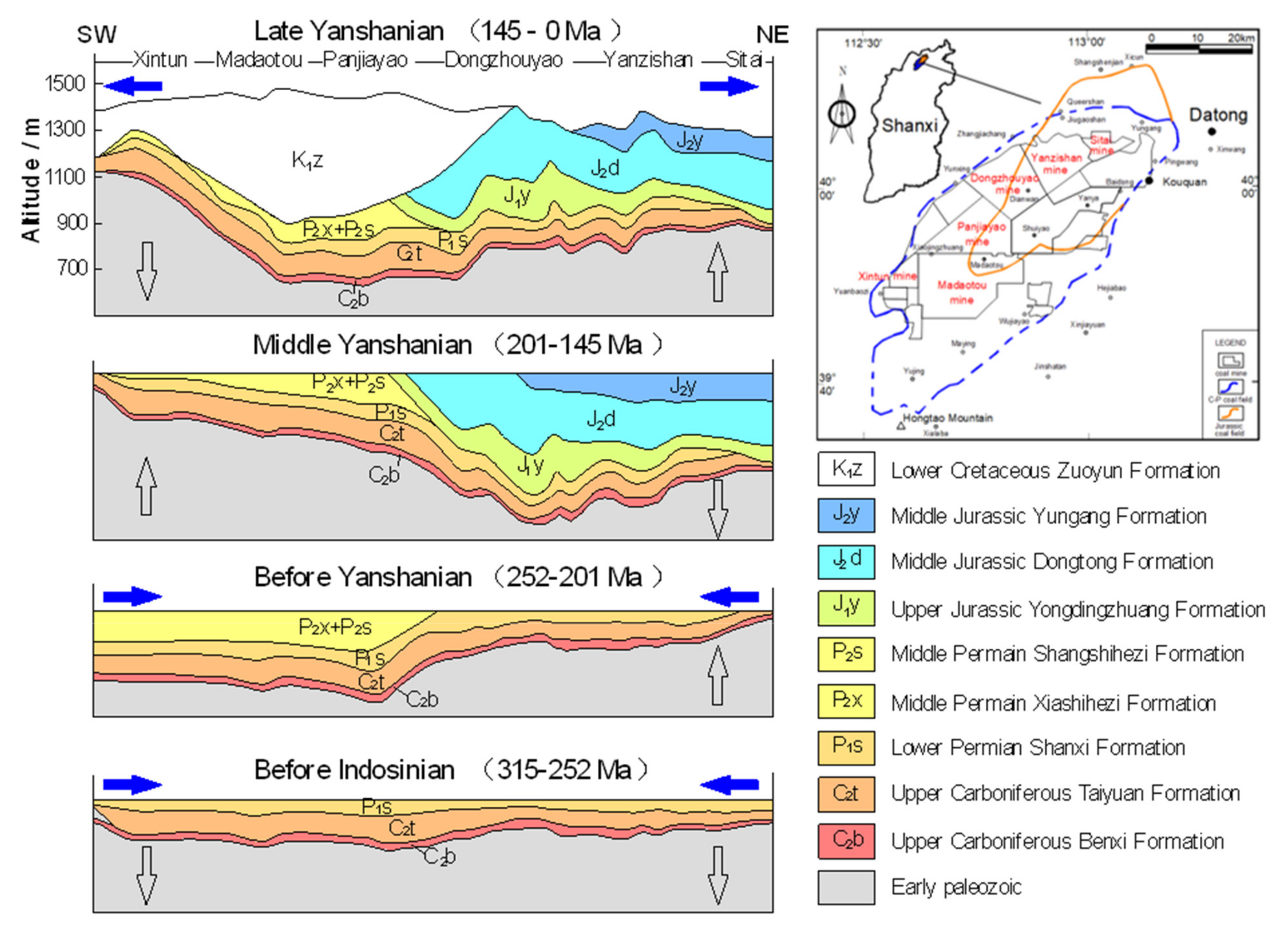
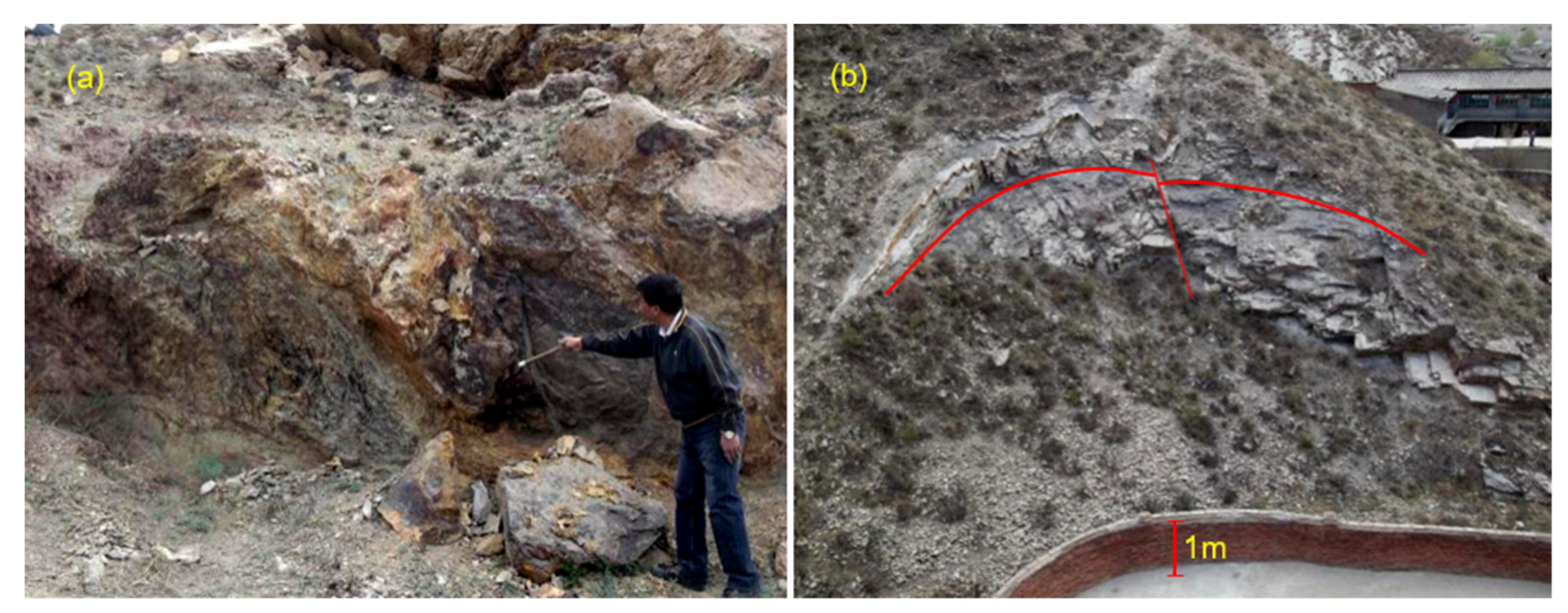
| No. | C8 Ro,max | Tpeak | No. | C8 Ro,max | Tpeak | No. | C8 Ro,max | Tpeak | No. | C8 Ro,max | Tpeak | No. | PS4 Ro,max | Tpeak | No. | PS4 Ro,max | Tpeak |
|---|---|---|---|---|---|---|---|---|---|---|---|---|---|---|---|---|---|
| 1 | 0.96 | 147 | 20 | 0.82 | 127 | 39 | 0.73 | 112 | 58 | 0.67 | 101 | 1 | 0.83 | 128 | 20 | 0.7 | 106 |
| 2 | 0.96 | 147 | 21 | 0.82 | 127 | 40 | 0.72 | 110 | 59 | 0.67 | 100 | 2 | 0.81 | 125 | 21 | 0.69 | 105 |
| 3 | 0.94 | 144 | 22 | 0.82 | 126 | 41 | 0.71 | 109 | 60 | 0.66 | 99 | 3 | 0.81 | 125 | 22 | 0.69 | 105. |
| 4 | 0.93 | 143 | 23 | 0.8 | 124 | 42 | 0.71 | 108 | 61 | 0.65 | 98 | 4 | 0.8 | 124 | 23 | 0.67 | 101 |
| 5 | 0.88 | 135 | 24 | 0.8 | 124 | 43 | 0.7 | 107 | 62 | 0.65 | 97 | 5 | 0.79 | 121 | 24 | 0.67 | 101 |
| 6 | 0.86 | 134 | 25 | 0.79 | 123 | 44 | 0.7 | 107 | 63 | 0.64 | 96 | 6 | 0.78 | 120 | 25 | 0.67 | 101 |
| 7 | 0.86 | 133 | 26 | 0.79 | 123 | 45 | 0.7 | 107 | 64 | 0.64 | 96 | 7 | 0.76 | 117 | 26 | 0.67 | 101 |
| 8 | 0.86 | 132 | 27 | 0.79 | 123 | 46 | 0.69 | 106 | 65 | 0.64 | 95 | 8 | 0.75 | 115 | 27 | 0.67 | 101 |
| 9 | 0.85 | 132 | 28 | 0.79 | 122 | 47 | 0.69 | 105 | 66 | 0.64 | 94 | 9 | 0.75 | 115 | 28 | 0.67 | 101 |
| 10 | 0.85 | 131 | 29 | 0.79 | 122 | 48 | 0.69 | 105 | 67 | 0.63 | 94 | 10 | 0.75 | 115 | 29 | 0.66 | 99 |
| 11 | 0.85 | 131 | 30 | 0.78 | 120 | 49 | 0.69 | 105 | 68 | 0.63 | 94 | 11 | 0.75 | 115 | 30 | 0.65 | 98 |
| 12 | 0.85 | 131 | 31 | 0.78 | 120 | 50 | 0.69 | 105 | 69 | 0.63 | 93 | 12 | 0.75 | 115 | 31 | 0.64 | 95 |
| 13 | 0.85 | 131 | 32 | 0.78 | 120 | 51 | 0.69 | 105 | 70 | 0.63 | 93 | 13 | 0.74 | 114 | 32 | 0.64 | 95 |
| 14 | 0.84 | 130 | 33 | 0.78 | 120 | 52 | 0.69 | 104 | 71 | 0.62 | 92 | 14 | 0.74 | 113 | 33 | 0.62 | 92 |
| 15 | 0.84 | 129 | 34 | 0.77 | 119 | 53 | 0.68 | 103 | 72 | 0.61 | 90 | 15 | 0.73 | 112 | 34 | 0.61 | 89 |
| 16 | 0.83 | 128 | 35 | 0.77 | 119 | 54 | 0.68 | 103 | 73 | 0.61 | 90 | 16 | 0.73 | 112 | 35 | 0.59 | 84 |
| 17 | 0.83 | 128 | 36 | 0.77 | 119 | 55 | 0.68 | 102 | 74 | 0.61 | 89 | 17 | 0.72 | 110 | — | — | — |
| 18 | 0.83 | 128 | 37 | 0.75 | 116 | 56 | 0.67 | 101 | 75 | 0.59 | 85 | 18 | 0.72 | 110 | — | — | — |
| 19 | 0.82 | 127 | 38 | 0.73 | 113 | 57 | 0.67 | 101 | 76 | 0.57 | 80 | 19 | 0.71 | 108 | — | — | — |
| No. | C8 Borehole | Ro,max | Tpeak(°C) | PS4 Borehole | Ro,max | Tpeak(°C) | No. | C8 Borehole | Ro,max | Tpeak(°C) | PS4 Borehole | Ro,max | Tpeak(°C) |
|---|---|---|---|---|---|---|---|---|---|---|---|---|---|
| 1 | 303 | 5.16 | 362 | W907 | 5.36 | 367. | 7 | 705 | 3.70 | 320 | W7 | 2.34 | 261 |
| 2 | 2105 | 4.96 | 357 | W901 | 4.88 | 355 | 8 | 1907 | 3.60 | 316 | 2504 | 2.16 | 251 |
| 3 | 8404 | 4.70 | 350 | W603 | 4.58 | 347 | 9 | 2106 | 3.57 | 315 | W5 | 1.92 | 236 |
| 4 | 2203 | 4.41 | 342 | W3 | 4.23 | 3367 | 10 | 8401 | 3.49 | 312 | W1006 | 1.15 | 170 |
| 5 | 1706 | 4.13 | 334 | W13 | 3.85 | 324 | 11 | 2306 | 3.00 | 293 | W14 | 1.09 | 163 |
| 6 | 8518 | 3.75 | 321 | W506 | 3.21 | 301 | 12 | T901 | 2.24 | 255 | — | — | — |
| Coal seam | Ro,max | Tpeak | Coal seam | Ro,max | Tpeak | Coal seam | Ro,max | Tpeak | Coal seam | Ro,max | Tpeak |
|---|---|---|---|---|---|---|---|---|---|---|---|
| J2 | 0.78 | 120 | J7 | 0.71 | 108 | J11 | 0.69 | 105 | J14 | 0.76 | 117 |
| J2 | 0.65 | 97 | J7 | 0.67 | 101 | J11 | 0.73 | 112 | J14 | 0.75 | 115 |
| J2 | 0.63 | 93 | J7 | 0.75 | 115 | J11 | 0.70 | 107 | J14 | 0.61 | 89 |
| J2 | 0.66 | 99 | J8 | 0.61 | 89 | J11 | 0.67 | 101 | J14 | 0.78 | 120 |
| J2 | 0.75 | 115 | J8 | 0.60 | 87 | J11 | 0.69 | 105 | J14 | 0.75 | 115 |
| J2 | 0.69 | 105 | J8 | 0.74 | 114 | J11 | 0.73 | 112 | J14 | 0.87 | 134 |
| J2 | 0.70 | 107 | J8 | 0.78 | 120 | J11 | 0.76 | 117 | J14 | 0.72 | 110 |
| J2 | 0.70 | 107 | J9 | 0.67 | 101 | J12 | 0.74 | 114 | J14 | 0.80 | 124 |
| J3 | 0.69 | 105 | J9 | 0.74 | 114 | J12 | 0.76 | 117 | J14 | 0.80 | 124 |
| J3 | 0.75 | 115 | J9 | 0.55 | 76 | J12 | 0.70 | 107 | J14 | 0.70 | 107 |
| J3 | 0.75 | 115 | J9 | 0.65 | 97 | J12 | 0.70 | 107 | J14 | 0.64 | 95 |
| J3 | 0.55 | 76 | J9 | 0.70 | 107 | J12 | 0.72 | 110 | J14 | 0.87 | 134 |
| J3 | 0.75 | 115 | J10 | 0.64 | 95 | J12 | 0.65 | 97 | J15 | 0.89 | 137 |
| J3 | 0.64 | 95 | J10 | 0.65 | 97 | J12 | 0.69 | 105 | J10 | 0.81 * | 125 |
| J3 | 0.63 | 93 | J10 | 0.72 | 110 | J12 | 0.80 | 124 | JJ2 | 0.813 | 126 |
| J3 | 0.75 | 115 | J10 | 0.74 | 114 | J12 | 0.76 | 117 | JJ3 | 0.851 | 136 |
| J4 | 0.54 | 73 | J10 | 0.72 | 110 | J12 | 0.79 | 122 | JJ7 | 0.872 | 135 |
| J5 | 0.51 | 66 | J10 | 0.60 | 87 | J12 | 0.77 | 119 | JS12 | 0.666 | 100 |
| J5 | 0.62 | 91 | J10 | 0.72 | 110 | J12 | 0.85 | 131 | JS14 | 0.734 | 113 |
| J5 | 0.61 | 89 | J10 | 0.72 | 110 | J12 | 0.76 | 117 | JX11 | 0.587 | 84 |
| J5 | 0.52 | 69 | J11 | 0.78 | 120 | J12 | 0.70 | 107 | JX15 | 0.746 | 115 |
| J7 | 0.72 | 110 | J11 | 0.74 | 114 | J14 | 0.93 | 143 | JQ7 | 0.684 | 104 |
| J7 | 0.59 | 85 | J11 | 0.64 | 95 | J14 | 0.72 | 110 | JQ11 | 0.739 | 114 |
| J7 | 0.69 | 105 | J11 | 0.74 | 114 | J14 | 0.63 | 93 | JY14 | 0.577 | 82 |
| J7 | 0.94 | 144 | J11 | 0.65 | 97 | J14 | 0.68 | 103 | — | — | — |
| J7 | 0.69 | 105 | J11 | 0.67 | 101 | J14 | 0.76 | 117 | — | — | — |
| Mineral | Sample | Strata | Strata Age/Ma | ρs/(105/cm2) (Ns) | Ρi/(105/cm2) (Ni) | Ρd/(105/cm2) (-) | P(χ2)/% | Central Age/Ma (±1σ) | Pooled Age /Ma (±1σ) | Length /µm(n) | Grain (N) |
|---|---|---|---|---|---|---|---|---|---|---|---|
| apatite | KKA | K1z | 100.5 ~145.0 | 2.736 (78) | 12.383 (353) | 18.079 (8116) | 98.9 | 78 ± 11 | 78 ± 11 | 12 | |
| KJA | J2d | 168.3 ± 1.3~174.1 ± 1.0 | 1.834 (330) | 14.826 (2667) | 18.52 (8116) | 98.1 | 45 ± 3 | 45 ± 3 | 12.1 ± 2.2 (100) | 28 | |
| KPA | P1s | 283.5 ± 0.6~298.9 ± 0.15 | 1.674 (412) | 16.741 (4119) | 18.3 (8116) | 100 | 36 ± 3 | 36 ± 3 | 12.0 ± 2.2 (84) | 28 | |
| zircon | KJZ | J2d | 168.3 ± 1.3~174.1 ± 1.0 | 120.788 (5723) | 50.882 (2408) | 13.134 (10030) | 61.6 | 157 ± 7 | 157 ± 7 | 24 | |
| KPZ | P1s | 283.5 ± 0.6~298.9 ± 0.15 | 114.329 (7586) | 36.758 (2439) | 13.478 (10030) | 0 | 202 ± 18 | 211 ± 10 | 27 | ||
| KCZ | C3t | 298.9 ± 0.15~307.0 ± 0.1 | 78.346 (5545) | 28.626 (2026) | 12.905 (10030) | 0.6 | 179 ± 9 | 178 ± 8 | 29 |
Publisher’s Note: MDPI stays neutral with regard to jurisdictional claims in published maps and institutional affiliations. |
© 2022 by the authors. Licensee MDPI, Basel, Switzerland. This article is an open access article distributed under the terms and conditions of the Creative Commons Attribution (CC BY) license (https://creativecommons.org/licenses/by/4.0/).
Share and Cite
Liu, D.; Lin, J.; Zhou, A.; Zhao, F.; Zhou, R.; Zou, Y. Tectono-Thermal Events of Coal-Bearing Basin in the Northern North China Craton: Evidence from Zircon–Apatite Fission Tracks and Vitrinite Reflectance. Minerals 2022, 12, 942. https://doi.org/10.3390/min12080942
Liu D, Lin J, Zhou A, Zhao F, Zhou R, Zou Y. Tectono-Thermal Events of Coal-Bearing Basin in the Northern North China Craton: Evidence from Zircon–Apatite Fission Tracks and Vitrinite Reflectance. Minerals. 2022; 12(8):942. https://doi.org/10.3390/min12080942
Chicago/Turabian StyleLiu, Dongna, Junwei Lin, Anchao Zhou, Fenghua Zhao, Rui Zhou, and Yu Zou. 2022. "Tectono-Thermal Events of Coal-Bearing Basin in the Northern North China Craton: Evidence from Zircon–Apatite Fission Tracks and Vitrinite Reflectance" Minerals 12, no. 8: 942. https://doi.org/10.3390/min12080942
APA StyleLiu, D., Lin, J., Zhou, A., Zhao, F., Zhou, R., & Zou, Y. (2022). Tectono-Thermal Events of Coal-Bearing Basin in the Northern North China Craton: Evidence from Zircon–Apatite Fission Tracks and Vitrinite Reflectance. Minerals, 12(8), 942. https://doi.org/10.3390/min12080942







